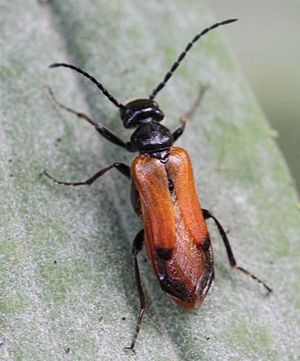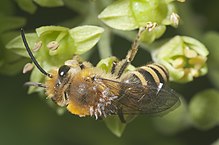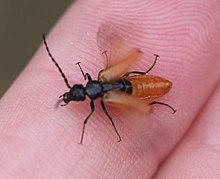Silk bee oil beetle
| Silk bee oil beetle | ||||||||||||
|---|---|---|---|---|---|---|---|---|---|---|---|---|

Silk bee oil beetle ( Stenoria analis ) |
||||||||||||
| Systematics | ||||||||||||
|
||||||||||||
| Scientific name | ||||||||||||
| Stenoria analis | ||||||||||||
| ( Foam , 1859) |
The silk bee oil beetle or black fur bee oil beetle ( Stenoria analis ) is a beetle from the family of the oil beetles (Meloidae).
distribution
The distribution area of the beetle species extends from North Africa and the Iberian Peninsula across southern Europe to Asia Minor and southern Russia. In Central Europe (France, Channel Islands, West Germany) the stenotopic and xerophilic species occur only locally. In western Germany it was already considered extinct. Since 2013, sightings of individual specimens in Hesse and in the Upper Rhine Plain have been known.
features
The beetles are about 12 mm tall. The head, pronotum and shield are black. The antennae and legs are also black. The light brown wing covers are black at the tips and only partially cover the light brown-orange colored abdomen and the transparent wing membrane.
Way of life
The silk bee oil beetle is a brood parasite . The triungulins (primary larvae) of the oil beetle attract ivy silk bees ( Colletes hederae ) with sexual pheromones . Other species of silk bees are also parasitized. They attach themselves to these and so get into their nest holes, where they continue to develop. The beetle larvae feed on the nectar and pollen collected by the female silk bees. The adult beetles can be seen from late July to early September. They feed on the flowers of various plants, including mullein ( Verbascum ).
Stages of development
The stages of development of the beetle species are outlined below:
Web links
- Please help with the search for occurrences of the silk bee oil beetle Stenoria analis . www.wildbienen.info. 15th September 2016.
Individual evidence
- ↑ John Lückmann: Oil beetle Stenoria anal in Germany - request for cooperation . Working group of Rhenish coleopterologists. Retrieved October 1, 2016.
- ↑ Jussi Lehtonen, Michael R. Whitehead: Sexual deception: Coevolution or inescapable exploitation? (PDF (1.1 MB)) Current Zoology 60 (1): 52–61, 2014.
- ↑ Peter Weiser: Current observations of the new citizen Stenoria analis Schaum 1859, in North Baden (Coleoptera: Meloidae) (PDF, 1.6 MB) Mitt. Ent. Ver. Stuttgart, vol. 51, 2016. pp. 63-68. Retrieved August 10, 2018.







